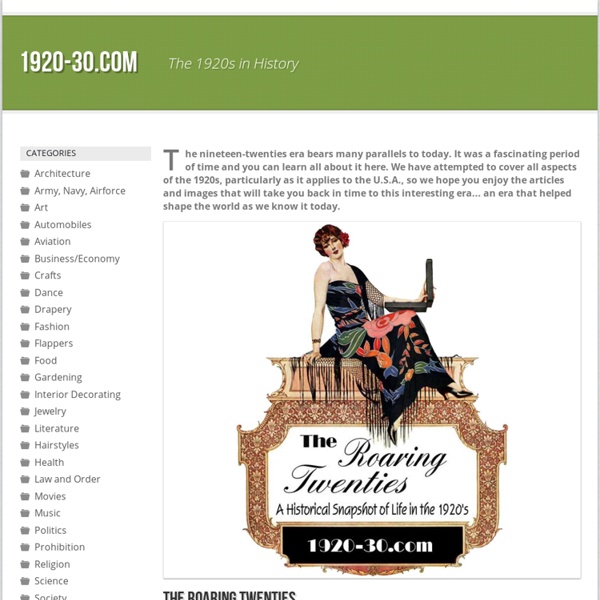1920's Ladies Underwear
Each year that passed saw changes in women's underwear and this is best illustrated through the images that accompany the articles below. A selection of articles on womens underwear in the 1920s Spencer Corset Advertisement in the Ladies Home Journal, May 1922
Remembering Pearl Harbor: The USS Arizona Memorial
Today the battle-scarred, submerged remains of the battleship USS Arizona rest on the silt of Pearl Harbor, just as they settled on December 7, 1941. The ship was one of many casualties from the deadly attack by the Japanese on a quiet Sunday that President Franklin Roosevelt called "a date which will live in infamy." The Arizona's burning bridge and listing mast and superstructure were photographed in the aftermath of the Japanese attack, and news of her sinking was emblazoned on the front page of newspapers across the land.
1920s
The 1920s was a decade that began on January 1, 1920 and ended on December 31, 1929. It is sometimes referred to as the Roaring Twenties or the Jazz Age, when speaking about the United States and Canada. In Europe the decade is sometimes referred to as the "Golden Age Twenties"[1] because of the economic boom following World War I. Since the end of the 20th century, the economic strength during the 1920s has drawn close comparison with the 1950s and 1990s, especially in the United States of America. These three decades are regarded as periods of economic prosperity, which lasted throughout nearly each entire decade. Each of the three decades followed a tremendous event that occurred in the previous decade (World War I and Spanish flu in the 1910s, World War II in the 1940s, and the end of the Cold War in the late 1980s).
Flappers and the Roaring 20's - www
Flappers were a so-called new style of Western woman, and the term “flapper” was invented to describe this so-called new breed. Initiated in the 1920s, the term “flapper” described women who flamboyantly flouted their contempt for what was back then deemed as societal behavior that was conventional. Flappers were women who were characterized by their choice of bobbed hair, short skirts, and their enjoyment of jazz music. They were branded as brash for their enjoyment of casual sex, drinking, immoderate makeup, driving cars and smoking. The origins of flappers, ideologically, were seen as being rooted in liberalism. There is debate over what the etymology of the word “flapper” really is.
1920s Timeline - History Timeline of the 1920s
Education 20th Century History Share this page on: Send to a Friend via Email
1920's Womens Fashion
Cosmetics of any kind, especially rouge, lip Sticks, and powder, if used, should be of excellent quality in order to be safe. And by excellent quality I mean the kinds that are manufactured by reputable firms and indorsed in advertisements by leading magazines. There is danger in cheap powder because of the metallic substance used for its foundation. More expensive powders, those with rice as their base, dust off more easily than do the cheaper grades. If you feel that the standard brands are too expensive for you, purchase toilet rice flour.
Salem Witchcraft: the Events and Causes of the Salem Witch Trials
By Tim Sutter © 2000-2003 What caused the Salem witch trials of 1692? This question has been asked for over 300 years. Although it is a simple question, it does not have an easy answer. The answer is difficult because there are numerous factors and events that helped create and influence the trials.
Speakeasy
New York's 21 Club was a Prohibition-era speakeasy. A speakeasy, also called a blind pig or blind tiger, is an establishment that illegally sells alcoholic beverages. Such establishments came into prominence in the United States during the Prohibition era (1920–1933, longer in some states). During that time, the sale, manufacture, and transportation (bootlegging) of alcoholic beverages was illegal throughout the United States.[1] Speakeasies largely disappeared after Prohibition was ended in 1933, and the term is now used to describe some retro style bars.



